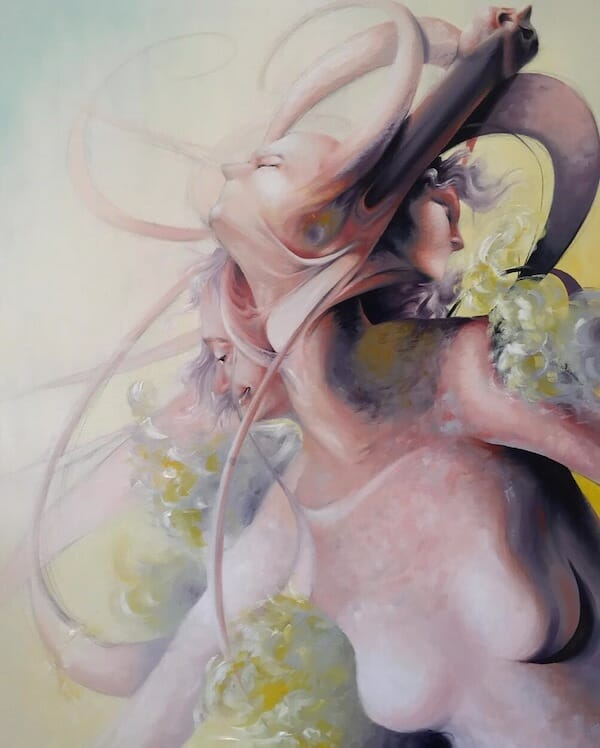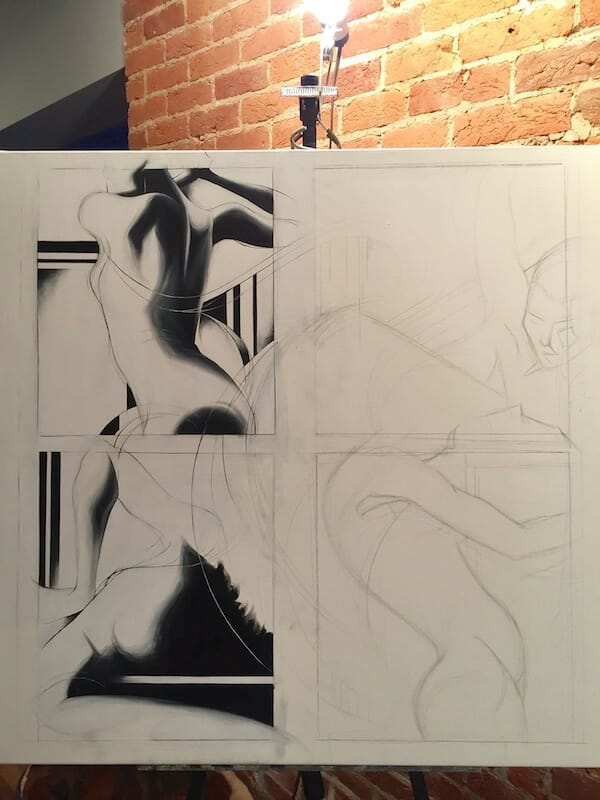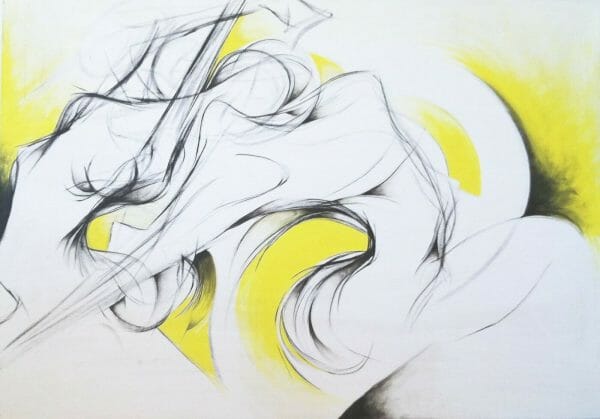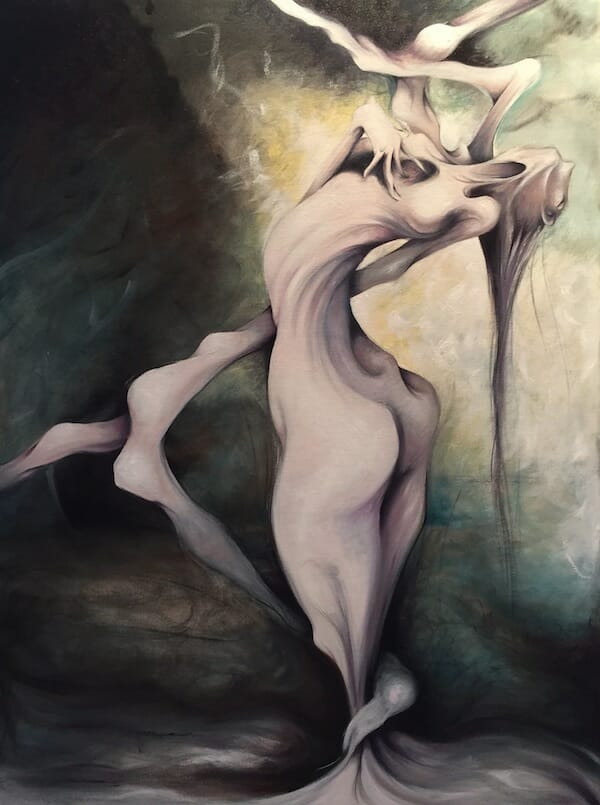Battles of the mind are frequently present in the works of artists, albeit often unintentional, subconscious occurrences. In the case of Sumner Crenshaw, working through anxiety and depression is a main focus of her oil paintings. Sumner works from her home in Maryland, USA, creating minimalistic, abstract, surreal artwork on canvas. These works strongly rely on smooth line work to suggest nude figures and geometric shapes. Swatches of yellow and red illuminate and accent forms and design, projecting power and strength. Each of her paintings represents a victory over anxiety, the female forms championing in the composition.
“Curly Girls” is the nickname for the characters presented in her works, from where the idea for her current body of work sparked. Formerly more busy and chaotic, Sumner’s paintings have evolved into a more simplistic and poetic nature. The “Curly Girls” is where it all began, when Sumner wanted to find a way to convey her strong emotions in a more direct and minimalistic way. Now the curved and flowing characters are prominent throughout her art series.
Sumner’s process starts fast, and then slows down as she adds more deliberate layers of paint over her preliminary sketches. The pieces begin as quick sketches on the canvas, where the graphite pencil lines blend into the paint, working to retain its spontaneous feel. The blueprint of her characters shines through the oil paints, adding overall depth and structure.
“It’s not uncommon for me to sketch a figure multiple times on the canvas and leave all the various iterations visible, as those harried lines create a sense of movement and urgency.” – Sumner Crenshaw
The extra forms and lines of the sketched figures become the abstracted shapes and colors of the finished painting. The result: twisted, graceful forms that have motion and rhythm, added to the freedom and strength of overcoming struggle.
Continue below to read our interview with Sumner Crenshaw and learn more about her work!
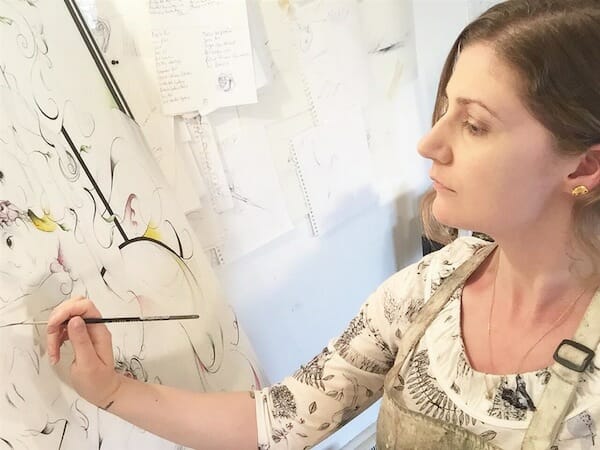 Sumner Crenshaw
Sumner Crenshaw
Please tell us how you evolved into your current painting style that involves more graceful, minimalistic, lines.
Looking back on my artistic development, I’ve always been fascinated, first and foremost, by lines. I think there is a bravery and beauty in simple lines, and over the years, I began working more and more towards paring my compositions down to their essence- what could I say with lines only? Did my images really need all the other stuff? Earlier, I feel like my images had a lot of bells and whistles, so to speak, which I think reflected my scattered mindset at the time but ultimately cluttered the images. I kept thinking to myself, “I want to make a graceful surrealism, something longing and eloquent”, and I kept reaching for a way to make surrealistic narratives that were understated and poetic, rather than in your face. It’s sort of like I wanted to take the imagery of Dali but render it in the simplified lines of Matisse. I want to make the grotesque graceful.


Your paintings are abstract and minimalistic, yet they involve many meticulous steps. Do you mind walking us through your process and timetable for completing a piece?
I feel like my process is both laughably simple and subtly tedious. I usually start by using a quick sketch as a reference and drawing directly on the canvas. It’s not uncommon for me to sketch a figure multiple times on the canvas and leave all the various iterations visible, as those harried lines create a sense of movement and urgency. There’s a balance between planning and spontaneity, as I’ll stay pretty true to my original concept but also use those spontaneous sketch lines to add shapes and turns to the forms- this is where things start to become even more abstracted. I’ve lately taken to going directly over the pencil marks with white oil paint, which preserves the lines and almost looks like a painted sketch. With some more surreal pieces, I’ll work in multiple layers, but with my Curly Girls, I paint wet on wet and use a tiny #1 rigger brush to get the fine lines. Curly Girls I like to bust out in one or two sittings, but for most of my other work I like to take my time, even several weeks, so that I can live with the piece and engage with it.

I would love to know more about what I’ve seen referred to as “Curly Girls” in your previous writings! Could you give us an introduction?
As I mentioned above, I’ve always been concerned with paring images down to their essence and with the emotion and movement that can be communicated with simple lines. The Curly Girls started as an extension of this exploration: one night in the studio I decided to try painting a female figure using as few lines as possible and using no color. Since I had nothing to lean on visually but lines, I tried to bend and shape them into curls and swirls to add complexity. It was my painted dream come true: a figure in its most basic, expressive form, only lines and curves, no color or tone. From there, I began to paint more figures, each time trying to simplify the lines I used to render the forms and forcing myself to stay away from detailed rendering by focusing on flowing, suggestive lines. I then began to explore graphic ideas like stripes and dots, things I once would’ve balked at putting in a painting. At the same time, I started envisioning a sort-of Curly Girl character: lively, confident, playful, a burlesque dancer strutting on a stage. This gave the paintings their personality, as they came to represent an empowered femininity that was quite the opposite of the melancholic, fraught women in my earlier images. In a way, the Curly Girls were a respite from my other paintings, a way to have fun and enjoy lines and shapes for their own sake, and I think they also represented where I grew as an artist and person: more confident, unafraid and open.

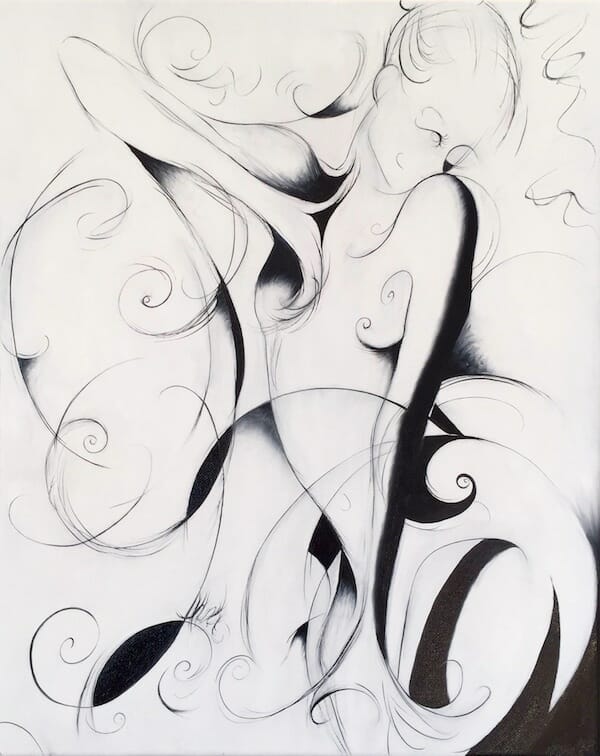
I’ve noticed the frequent use of reds and yellows in your finished work. Could you explain how you came to use these colors and what they represent?
I think I’m drawn to red and yellow in particular because of their power and expressiveness. With the yellow, it’s a technical choice as much as an artistic one. I’ve been gradually going a little bit more subtle in my work, and yellow has almost started functioning like a neutral for me: it adds to the color story and packs a visual punch, but it lacks the anger inherent in reds and crimsons, which is something I reached for a lot in my earlier work that I’ve been steadily toning down. Also, in a lot of my paintings, I like to picture the figures under a bright yellow spotlight, like they’re on some kind of stage.
With red, I’ve always just had a love affair with the color, but I also admire its expressiveness-although, as mentioned above, red has become tricky for me as it tends to read as viscerally angry, which is not necessarily what I’m going for now. I like that red reads as powerful, and I’ve been using it as a way to express strength.
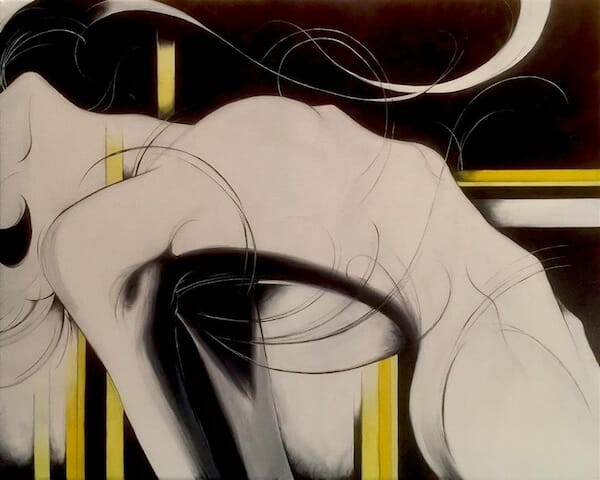

Why should others use the arts as a form of healing for their own struggles, such as you have for anxiety and depression?
I’m a true believer that art saves, and I think it’s a profoundly valuable way to explore our darkest thoughts and work through them. Some people tend to be afraid of imagery that is angry or dark, as if it means the creator only lives in a space of negativity, and that flies in the face of the positivity we are always expected to project. I disagree; I think it is healing to reflect upon what makes us angry, scared or upset; and doing so doesn’t define us as much as it helps us to explore another facet of the human experience, which in turn makes those overwhelming emotions seem a little less daunting. With anxiety and depression, it is important to understand that you have the emotion, the emotion doesn’t have you, and it is incredibly empowering to explore and define, and therefore overcome, those emotions through image-making.
